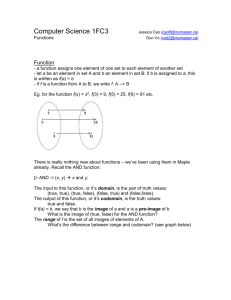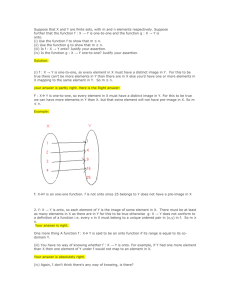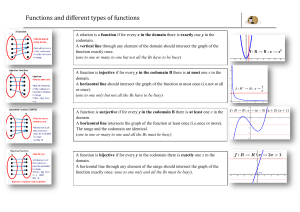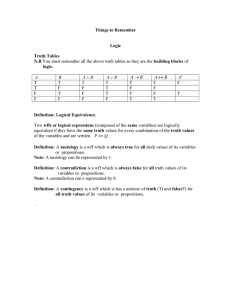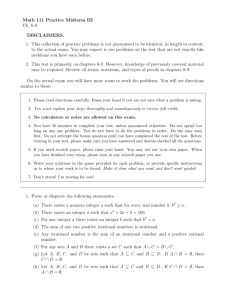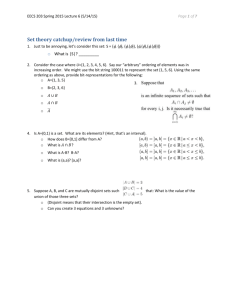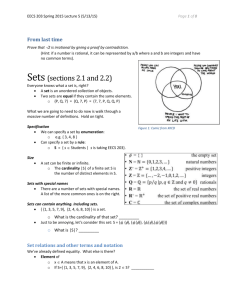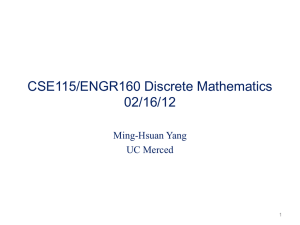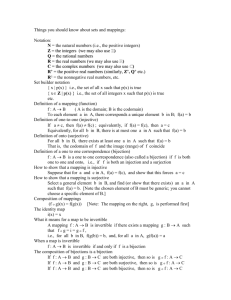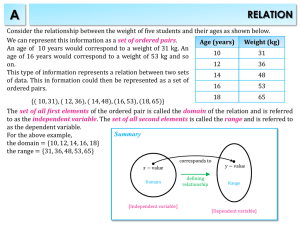Functions
advertisement
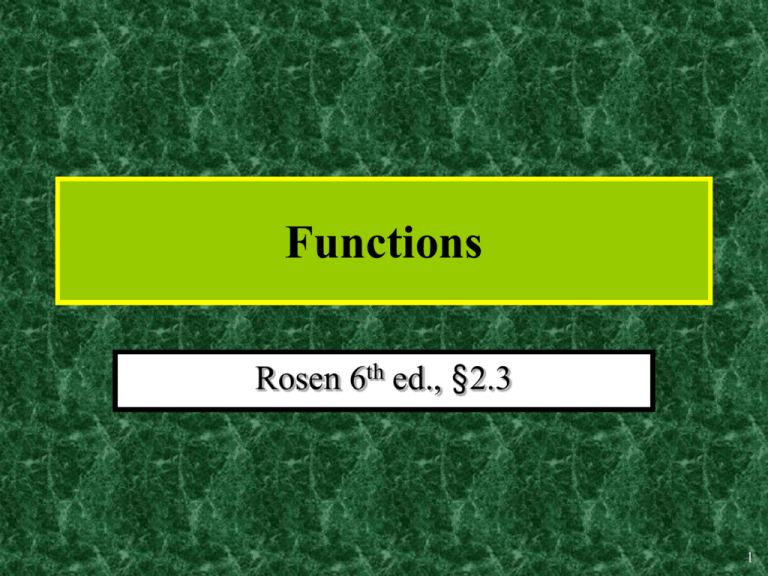
Functions
Rosen 6th ed., §2.3
1
Definition of Functions
• Given any sets A, B, a function f from (or
“mapping”) A to B (f:AB) is an
assignment of exactly one element f(x)B
to each element xA.
2
Graphical Representations
• Functions can be represented graphically in
several ways:
f
a•
A
f
•
b
B
Like Venn diagrams
A
•
•
•
•
•
B
•
•
•
•
Graph
y
x
Plot
3
Definition of Functions (cont’d)
• Formally: given f:AB
“x is a function” : (x,y: x=y f(x) f(y)) or
“x is a function” : ( x,y: (x=y) (f(x) f(y))) or
“x is a function” : ( x,y: (x=y) (f(x) = f(y))) or
“x is a function” : ( x,y: (x=y) (f(x) = f(y))) or
“x is a function” : ( x,y: (f(x) f(y)) (x y))
4
Some Function Terminology
• If f:AB, and f(a)=b (where aA & bB),
then:
–
–
–
–
A is the domain of f.
B is the codomain of f.
b is the image of a under f.
a is a pre-image of b under f.
• In general, b may have more than one pre-image.
– The range RB of f is {b | a f(a)=b }.
5
Range vs. Codomain - Example
• Suppose that: “f is a function mapping
students in this class to the set of grades
{A,B,C,D,E}.”
• At this point, you know f’s codomain is:
__________, and its range is ________.
{A,B,C,D,E}
unknown!
• Suppose the grades turn out all As and Bs.
{A,B} but its
• Then the range of f is _________,
codomain is __________________.
still {A,B,C,D,E}!
6
Function Addition/Multiplication
• We can add and multiply functions
f,g:RR:
– (f g):RR, where (f g)(x) = f(x) g(x)
– (f × g):RR, where (f × g)(x) = f(x) × g(x)
7
Function Composition
• For functions g:AB and f:BC, there is a
special operator called compose (“○”).
– It composes (i.e., creates) a new function out of f,g by
applying f to the result of g.
(f○g):AC, where (f○g)(a) = f(g(a)).
– Note g(a)B, so f(g(a)) is defined and C.
– The range of g must be a subset of f’s domain!!
– Note that ○ (like Cartesian , but unlike +,,) is noncommuting. (In general, f○g g○f.)
8
Function Composition
9
Images of Sets under Functions
• Given f:AB, and SA,
• The image of S under f is simply the set of
all images (under f) of the elements of S.
f(S) : {f(s) | sS}
: {b | sS: f(s)=b}.
• Note the range of f can be defined as simply
the image (under f) of f’s domain!
10
One-to-One Functions
• A function is one-to-one (1-1), or injective,
or an injection, iff every element of its
range has only one pre-image.
• Only one element of the domain is mapped
to any given one element of the range.
– Domain & range have same cardinality. What
about codomain?
11
One-to-One Functions (cont’d)
• Formally: given f:AB
“x is injective” : (x,y: xy f(x)f(y)) or
“x is injective” : ( x,y: (xy) (f(x)f(y))) or
“x is injective” : ( x,y: (xy) (f(x) f(y))) or
“x is injective” : ( x,y: (xy) (f(x) f(y)))
or
“x is injective” : ( x,y: (f(x)=f(y)) (x =y))
12
One-to-One Illustration
• Graph representations of functions that are
(or not) one-to-one:
•
•
•
•
•
•
•
•
•
One-to-one
•
•
•
•
•
•
•
•
•
Not one-to-one
•
•
•
•
•
•
•
•
•
Not even a
function!
13
Sufficient Conditions for 1-1ness
• Definitions (for functions f over numbers):
– f is strictly (or monotonically) increasing iff
x>y f(x)>f(y) for all x,y in domain;
– f is strictly (or monotonically) decreasing iff
x>y f(x)<f(y) for all x,y in domain;
• If f is either strictly increasing or strictly
decreasing, then f is one-to-one.
– e.g. f(x)=x3
14
Onto (Surjective) Functions
• A function f:AB is onto or surjective or a
surjection iff its range is equal to its
codomain (bB, aA: f(a)=b).
• An onto function maps the set A onto (over,
covering) the entirety of the set B, not just
over a piece of it.
– e.g., for domain & codomain R, x3 is onto,
whereas x2 isn’t. (Why not?)
15
Illustration of Onto
• Some functions that are or are not onto their
codomains:
•
•
•
•
•
•
•
•
•
Onto
(but not 1-1)
•
•
•
•
•
•
•
•
•
Not Onto
(or 1-1)
•
•
•
•
•
•
•
•
Both 1-1
and onto
•
•
•
•
•
•
•
•
•
1-1 but
not onto
16
Bijections
• A function f is a one-to-one
correspondence, or a bijection, or
reversible, or invertible, iff it is both oneto-one and onto.
17
Inverse of a Function
• For bijections f:AB, there exists an
inverse of f, written f 1:BA, which is the
unique function such that:
f
1
f I
18
Inverse of a function (cont’d)
19
The Identity Function
• For any domain A, the identity function
I:AA (variously written, IA, 1, 1A) is the
unique function such that aA: I(a)=a.
• Some identity functions you’ve seen:
– ing with T, ing with F, ing with , ing
with U.
• Note that the identity function is both oneto-one and onto (bijective).
20
Identity Function Illustrations
• The identity function:
•
•
•
•
•
•
•
y
•
•
Domain and range
x
21
Graphs of Functions
• We can represent a function f:AB as a set
of ordered pairs {(a,f(a)) | aA}.
• Note that a, there is only one pair (a, f(a)).
• For functions over numbers, we can
represent an ordered pair (x,y) as a point on
a plane. A function is then drawn as a curve
(set of points) with only one y for each x.
22
Graphs of Functions
23
A Couple of Key Functions
• In discrete math, we frequently use the
following functions over real numbers:
– x (“floor of x”) is the largest integer x.
– x (“ceiling of x”) is the smallest integer x.
24
Visualizing Floor & Ceiling
• Real numbers “fall to their floor” or “rise to
their ceiling.”
3
.
2
.
• Note that if xZ,
.
1
x x &
0
x x
.
1
.
• Note that if xZ,
.
2
x = x = x.
.. .
3
1.6=2
1.6
1.6=1
1.4= 1
1.4
1.4= 2
3
3=3= 3
25
Plots with floor/ceiling: Example
• Plot of graph of function f(x) = x/3:
f(x)
Set of points (x, f(x))
+2
3
+3
x
2
26
